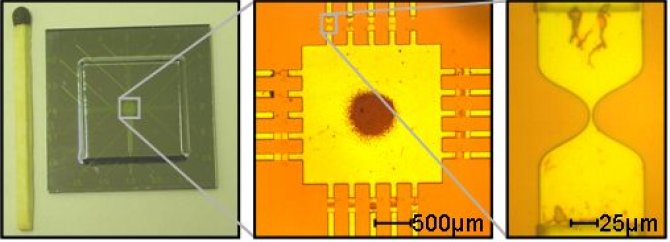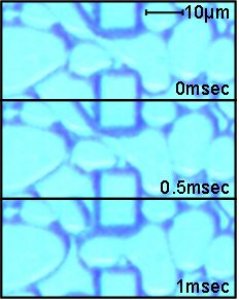Micro Static Dispersions
In pre-mix membrane emulsification the to-be-dispersed phase is mixed with the continuous phase by simple stirring. The resulting pre-mix, with a large droplet size and a large droplet size distribution is pushed, through a porous membrane. In the membrane the droplets break up in smaller droplets resulting in an emulsion with a small droplet size distribution (monodisperse). Not much is known about these break-up mechanisms. We study the break-up mechanisms inside the membrane using a microfluidic device.

The microfluidic device (Figure 1) is produced using methods that originated from the semiconductor industry. Channels shaped as Y-junctions, constrictions and combinations thereof where etched in silicon. The silicon was covered by glass. The diameter of the channels was varied from 1 to 10 µm. Emulsions could be pushed through the structures separately, through holes in de silicon. The movement of the emulsion droplets was studied using a microscope connected to a high-speed camera.
Two examples of pictures obtained within this study are shown in Figure 2 and 3. In both figures the flow is from left to right. Next to snap-off and break-up by steric hindrance of another droplet, shown in the figures, we found break-up caused by Rayleigh instabilities and break-up due to flow of continuous phase. The occurrence of these mechanisms in actual membranes will depend on the local trans membrane flow rate and on the presence of other droplets. Future studies and computer modeling will help elucidate the occurrence of the break-up mechanisms and membrane structures that are designed to make optimal use of the various break-up mechanisms.
Fig. 2 Snap-off of a droplet in a constriction. Click on the picture for a movie of this mechanism

Fig. 3 Break-up by impact of another droplet. Click on the picture for a movie of this mechanism